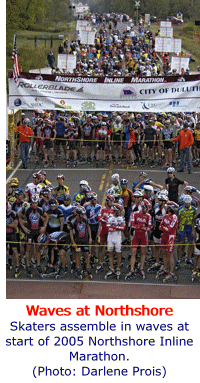 |  | |||||||||||||||||||||||||||||||||||||||
 | ||||||||||||||||||||||||||||||||||||||||
The Beginner's Guide to Outdoor Racing > Part 1 Race Categories
Categories determine which skaters you are competing against. Local traditions vary, but the usual categories, from lowest to highest, are Rec/Fitness, Advanced, and Pro. In a large race, each category has a separate start, with Pro further divided by gender (men and women) and by age (elite and masters). In Rec/Fitness and Advanced, skaters compete for awards only with skaters of their own gender and age group (usually in 10 year increments). However, they are allowed to skate with (that is, draft or be in a paceline with) anyone else in the same category. Therefore, a 30-year-old Advanced woman could skate with a 60-year-old Advanced man, but would be ranked in the final event results only in relation to her position against other Advanced women in their 30s. Small local races and large races with long, hilly courses usually have mass starts. That means that everyone starts together, and racers are free to skate with anyone at any time, regardless of age, category, gender, registered distance, etc., though final rankings are based on how skaters finish in their gender, category and age group. On a practical level, the categories are based less on finishing times than on a group's competitive attitude and skill at pack racing. If it's your first race and the categories have separate starts, choose Rec/Fitness — people will be very friendly, you can wear any kind of skates, and you don't have to skate in a paceline unless you want to. In Advanced, where people wear racing skates, competition is somewhat friendly, but you should already know how to behave in a paceline or it won't be fun. In Pro, competitors are openly trying to ditch you, and succeeding requires a host of skills you can only get through lots of racing experience. Outside of the Rec/Fitness category, the bigger the race, the more pack skills you need, and the harder it is to get by just on strong legs and lungs. Even if you feel like you're pretty fast, you will not enjoy a race if you compete in a category above your skill level. Be patient and cultivate your skills. The people you skate with regularly are your best guides to what you can do on race day. Go to: Part 1 - Race Categories Part 2 - Drafting and Pacelines Part 3 - Race Dynamics and Interval Training Part 4 - Race Day: Fashion, Food and Packing Part 5 - Getting More Involved in Racing | Discuss Sections: Part 1 - Race Categories Part 2 - Drafting and Pacelines Part 3 - Race Dynamics and Interval Training Part 4 - Race Day: Fashion, Food and Packing Part 5 - Getting More Involved in Racing Related reading: | |||||||||||||||||||||||||||||||||||||||
... Copyright © 2006 by Robert Burnson | ||||||||||||||||||||||||||||||||||||||||

